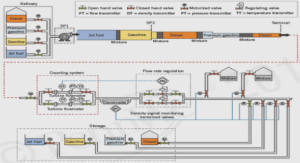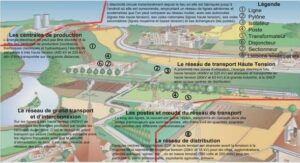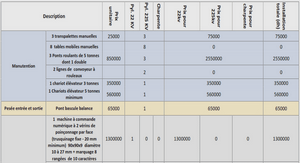Rapport de stage does lemming winter grazing impact vegetation in the Canadian Arctic?, tutoriel & guide de travaux pratiques en pdf.
Methods
The study site was located in the Qarlikturvik glacial valley (73° 08 ’N, 80°00’ W) on Bylot Island, Sirmilik National Park, Nunavut Territory. The study area (70 km2) consisted of tundra polygons, thaw lakes and ponds forming wetlands at the bottom of the valley and is surrounded by drier mesic tundra on the nearby slopes and hills, which account for 90% of the landscape on the south plain of Bylot Island. The wetlands form grass/sedge meadows dominated by mosses and graminoids (Dupontia fisheri, Eriophorum scheuchzeri and Carex aquatilis; Gauthier et al. 1996). The mesic tundra is dominated by prostrate shrubs (Salix spp., Dryas integrifolia, Cassiope tetragona) with a sparse cover of forbs (Saxifraga spp., Potentilla spp., Ranunculus spp., Pedicularis spp.), graminoids (Arctagrostis latifolia, Alopecurus alpinus, Poa spp., Luzula spp.), mosses and lichens. Small, intermittent streams running through upland areas were also often located at the bottom of small gullies and were characterized by a thin band of wetland vegetation surrounded by mesic tundra. These sites were especially important for lemmings during winter.
The most important herbivores present on the island are the two lemming species, which are present throughout the year, and the greater snow goose (Chen caerulescens atlantica), which is present only in summer. No other small mammal species are present and large mammalian herbivores are absent. Other herbivores such as the rock ptarmigan (Lagopus mutus) and arctic hare (Lepus arcticus) are present at low densities. The two lemming species show some segregation in their summer habitat, with brown lemmings preferring wetter and collared drier habitats (MacLean et al. 1974, Batzli et al. 1983, Morris et al. 2011). During winter, both species share the same habitats and concentrate in mesic tundra and especially in small gullies along streams which are conducive to deep snow accumulation (Duchesne et al. 2011b, Reid et al. 2012). According to the literature, the two species have divergent diets, with brown lemmings preferring monocotyledons and mosses and collared lemmings preferring dicotyledons (Batzli and Jung 1980, Rodgers and Lewis 1985, 1986, Negus and Berger 1998). However, recent data based on DNA barcoding (Soininen et al. 2009) suggests that brown lemmings may actually be concentrating on dicotyledons (primarily Salix spp.) and mosses and eat little monocotyledons during winter at our study site (E. Soininen and G. Gauthier, unpublished data).
Lemming exclosures
In late May and early June 2009, before snow-melt, we systematically measured snow depth in 95 sites of high snow accumulation, mostly snow drifts caused by topography. We retained sites showing snow depth >60 cm, which are preferred by lemmings during winter at our study site (Duchesne et al. 2011b). These sites were visited after snowmelt and those showing signs of lemming use (winter nests or piles of faeces) were noted. We randomly selected 16 of those sites (8 in mesic tundra and 8 in stream gullies) to set lemming exclosures in August 2009. Exclosures consisted of galvanized, welded wire fence (1.25-cm mesh size) attached to wooden stakes in each corner and were separated by at least 50 m. Each exclosure was 0.75 x 0.75 m, 1 m high, and the fence was driven 15 cm into the ground to prevent lemmings from digging under. In subsequent years, at the same time that vegetation was sampled in August (see below), exclosures were moved by at least 10 m to a new site showing signs of winter use by lemmings to avoid sampling the same site twice.
Plant biomass was sampled in quadrats twice a year: at the end of the growing season in early August and at snow melt in June (or early July in a few sites where snow persisted late). In August, a vegetation sample was taken at ~2 m from where the exclosure was set. At snow-melt, a first sample was taken inside the exclosure and a second one outside, again within 2 m of the exclosure. If the sample collected outside did not show any sign of lemming activity (e.g. shoot clipping, pile of faeces, etc.), we searched for these signs within a 5 m radius around the exclosure and collected a third sample at such site. Positions of quadrats outside exclosures were chosen randomly except for the third sample at snow-melt, when no signs of lemming activity had been found in the random quadrat. For the third quadrat, we sampled the first area where signs of lemming activity were detected. Vascular plants were sampled in 20×50 cm quadrats and mosses in a 10×10 cm sub-quadrat inside the previous one. All above ground vascular plants were clipped at the ground level. Dead material was removed and the remaining live material was sorted by family, genus or species, dried to constant mass at 45o C, and weighed. Salix were sorted into two categories, woody parts and leaves. Buds were included with leaves. Mosses were identified by genus or species on the 10×10 cm quadrat. Proportion cover of each genus or species was visually estimated in the field to the nearest 5 % before all above ground live (i.e. green) material was clipped (Pouliot et al. 2009). Clipped material was dried to constant mass at 45°C and weighed. Total weight was then divided by the proportion estimated for all genus or species.
We analysed the standing crop of each taxa (family, genus or species) of vascular plants and mosses using generalised linear models to test if we could detect a difference between (1) ungrazed (i.e. inside exclosure) and random plots outside exclosures and (2) ungrazed and grazed plots (i.e. those showing signs of lemming use outside exclosure) at snow-melt. We ran these two analyses separately because not all sites had both a random and a grazed plot. We hereafter refer to grazed and random plots as the treatment effects as both were potentially exposed to lemmings. Habitat (mesic tundra and stream gullies) and year were additional factors entered into the analysis and two-way interactions between those variables and the treatment effect were also examined (interactions are only reported when significant, i.e. P < 0.05). We further tested if biomass of each taxa at the end of the growing season remained stable throughout the study years, including habitat and its interaction with year, using a generalised linear model. All plant biomass data was transformed using natural logarithm to respect normality for analyses. We used Tukey’s test to compare individual means (or Least Square Means, LSM when there was a significant interaction). Statistical analyses were performed with R statistical software (http://cran.r-project.org/).
Lemming density
Lemming density was estimated each summer. We live trapped rodents on two 11-ha grids (330 x 330 m), one set out in wetlands and one in mesic tundra, to obtain mark-recapture estimation of abundance. The trapping grids were laid out in a Cartesian plane of rows and columns, with numbered stakes spaced every 30 m. At each stake, we set out a Longworth trap baited with apple near signs of lemming use or active burrows. Trapping occurred over 3 consecutive days 3 times during the summer (mid-June, mid-July and mid-August) and traps were checked twice a day. All individuals captured were identified to the species, marked with PIT tags (when unmarked) and released. We considered the lemming population closed within our trapping sessions. All density estimates were carried out in DENSITY 4.4 (http://www.otago.ac.nz/density) using Efford’s maximum likelihood method (Efford et al. 2004, Borchers and Efford 2008; see Bilodeau et al. 2013d for details).
Lemming winter nests provided us with an index of winter density (Krebs et al. 2012). We estimated nest density each spring, shortly after snow-melt, on 60 transects distributed randomly across the study area and equally in our 3 habitats (20 each in wetlands, mesic tundra and stream gullies). Transects were 500 m long and the same transects were used each year. All winter nests found while walking along the transect line were removed, their exact position and perpendicular distance to the transect noted, and the species using it identified (see Duchesne et al. 2011b for details). Nest density was estimated using line transect method (Buckland et al. 2001) and was carried out in Distance 6.0 (http://www.ruwpa.st-and.ac.uk/distance/), a software for distance sampling analysis (Thomas et al. 2009).
Results
Lemming population dynamic
The combination of winter nest and summer density data (Figs. 1 and 2) indicates that both species of lemmings had declined from high densities in summer 2008 to a near absence during the winter 2008-2009. Populations were extremely low during the summer 2009 but both species increased during winter 2009-2010 to reach high densities during summer 2010. Populations of both species remained high during the winter 2010-2011 but showed a divergent dynamic during summer 2011. Whereas brown lemmings reached very high densities during that summer, the collared lemming population had apparently crashed by the time snow had disappeared. By winter 2011-2012, brown lemmings had also declined to low numbers and densities of both species were low during summer 2012.
Impact of lemmings on plants during winter
The dominant vascular plants were the same in both habitats (Table 1), with Ericaceae and Salicaceae being the most abundant, followed by Juncaceae and Poaceae. In spring 2010, 12 out of 16 random quadrats had signs of lemming use, 14 out of 16 in spring 2011, but none in spring 2012. We found no differences in total vascular plant biomass between random sites outside the exclosures and ungrazed sites inside (F1,86 = 0.34, P = 0.561) nor between sites showing signs of lemming grazing and ungrazed sites (F1,86 = 0.92, P = 0.339; Fig. 3). There was more biomass in 2012 compared to 2010 and 2011 (random vs ungrazed: F2,86 = 4.25, P = 0.017; grazed vs ungrazed: F2,86 = 7.19, P = 0.001). This effect is mostly due to the high biomass of Cassiope tetragona (an Ericaceae) in and around our exclosures in spring 2012 (Fig. 4). Grazed sites tended to have less Cassiope in 2012 compared to ungrazed sites (P = 0.084), probably because these plants tend to overgrow other plants when present and are not eaten by lemmings.
Among 17 individual plant families, only four showed some evidence of an effect of lemmings’ winter grazing (for the others, P > 0.32 in all comparisons; see Annexe 3). There was no treatment effect on Salicaceae woody parts (random vs ungrazed: F1,86 = 0.23, P = 0.629; grazed vs ungrazed: F1,86 = 0.43, P = 0.515; Fig. 4) but biomass was higher in 2012 than in other years (F2,86 = 6.17, P = 0.003). Similarly, no treatment effect was detected on Salicaceae leaves (random vs ungrazed: F1,86 = 0.83, P = 0.364; grazed vs ungrazed: F1,86 = 0.10, P = 0.749) although leaf biomass was lower in 2011 than in the other 2 years (F2,86 = 13.5, P ˂ 0.001; Fig. 4). The large annual difference is possibly due to later sampling dates in 2010 and 2012 when Salix had already started to grow before snow on quadrats had completely melted. Biomass of Juncacea did not differ between inside and outside exclosures (random vs ungrazed: F1,86 = 0.07, P = 0.799; grazed vs ungrazed: F1,86 = 0.51, P= 0.476) nor that of Poaceae (random vs ungrazed: F1,86 = 0.75, P = 0.390; grazed vs ungrazed: F1,86 = 0.80, P = 0.375 Fig. 4). Caryophyllaceae biomass was reduced by 33 % in grazed sites compared to ungrazed sites (F1,86 = 5.97, P = 0.017; Fig. 4) but not in random sites (F1,86 = 0.73, P = 0.395). Papaveraceae, a rare family, showed inconsistent trends, its biomass being significantly lower in random compared to ungrazed sites but higher in grazed sites.
Dominant mosses were similar in both habitats (Table 2), with the genus Drepanocladus, Hylocomium, Polytrichum and Scapania being the most abundant. We found no differences in total live moss biomass between random sites and ungrazed sites within exclosures (F1,86˂ 0.001, P = 0.984), nor between sites showing signs of lemming grazing and ungrazed sites (F1,86 ˂ 0.001, P = 0.989; Fig. 3). The apparent decline in spring moss biomass over the years (F2,86 = 4.34, P = 0.016) is probably related to the high prevalence of Ericaceae in 2012, as explained above, because this decline was not apparent at the end of the growing season (see below). Evidence for an effect of lemming grazing was detected for 3 out of 32 individual moss species or genus. The effect on Polytrichum tended to vary among years with random plots (treatment x year: F2,86 = 2.48, P = 0.089). In grazed plots, biomass varied according to year (F2,86 = 3.59, P = 0.032) and tended to differ among treatments (F2,86 = 3.10, P = 0.082). Polytrichum biomass in random and grazed sites was about 57% lower than in ungrazed sites in 2010 but not in 2011 and 2012 (Fig. 4). The effect of grazing on Drepanocladus biomass varied with habitat but was inconsistent. Biomass was 9% lower in random than in ungrazed sites in mesic tundra but not in stream gullies (treatment x habitat; F2,86 = 3.33, P = 0.072) whereas biomass was 51% higher in grazed than in ungrazed sites in the stream gullies but not in the mesic tundra (treatment x habitat: F2,86 = 4.50, P = 0.037). Finally, Ptilidium biomass was also 56 % lower in grazed than in ungrazed sites but this time only in the stream gullies (treatment x habitat: F2,86 = 6.49, P = 0.013).
Annual variation in plant growth
Aboveground live vascular plant biomass at the end of the growing season tended to increase over the years (F3,56 = 2.07, P = 0.114) and was significantly higher in 2012 than in 2010 (Fig. 5). For individual vascular plant families, there were few differences among years, and trends were not always consistent (see Annexe 3 for details). The biomass of Salicaceae did not vary significantly among years (leaves: F3,55 = 0.76, P = 0.523; wood: F3,55 = 0.78, P = 0.509) although biomass appeared much higher in 2012 than in other years (Fig. 6). This was partly due to one exclosure showing an extremely high biomass (leaves: 101.5 g/m2; wood: 177.2 g/m2). Excluding this outlier, Salicaceae biomass in 2012 was 27.7 ± 6.3 g/m2 for leaves and 30.5 ± 6.3 g/m2 for wood. Poaceae biomass tended to differ among years (F3,56 = 2.71, P = 0.054; Fig. 6) as there was more biomass in 2012 compared to 2010 (Fig. 6). The biomass of Juncaceae did not vary among years (F3,56 = 0.21, P = 0.888). The biomass of Caryophyllaceae and Polygonaceae varied among years (F3,56 =4.03, P = 0.012 and F3,56 = 4.17, P = 0.010; respectively) as the biomass was higher in 2009 than in 2010, 2011 (both species) and 2012 (Polygonaceae only; Fig. 6).
Total moss biomass at the end of the growing season did not vary significantly among years (F3,56 = 0.97, P = 0.415; Fig. 5). Analysis of individual taxa revealed variable effects across species and sometimes also habitats. Aulacomnium tended to have higher biomass in 2012 than in other years (F3,56 = 2.23, P = 0.095), Cinclidium had higher biomass in 2009 than in other years (F3,56= 3.50, P = 0.021) and Scapania had lower biomass in 2009 than in other years (F3,56 = 7.86, P ˂ 0.001). Finally, annual change in biomass of Ditrichum flexicaule and Hylocomnium varied among habitats (interaction year x habitat: F3,56 = 3.30, P = 0.027 and F3,56 = 2.66, P = 0.057, respectively).
Discussion
During winter, plant growth stops under the snow and a large proportion of plant biomass is lost to senescence (Hansson 2002). Therefore, if small mammal populations are controlled by their resources, they should be particularly vulnerable to food shortage during winter, and years of high population densities should result in detectable signs of food depletion at snow melt. This is especially true for lemmings that can breed and show population growth under the snow, which would put even more pressure on their winter food supply.
We found weak evidence to support the hypothesis that winter grazing by lemmings reduced plant biomass in their preferred habitat and no support for the hypothesis that this impact should be highest during the winter of peak abundance (2010-2011 at our study site). Even when we selected sites with signs of lemming grazing, differences in biomass between these sites and those protected from grazing were small or absent. A significant but slight impact of winter grazing was detected on a few mosses known to be important food items for brown lemmings (Batzli et al. 1983), the most abundant lemming species at our site, and no effect was detected on Poaceae and Juncaceae. Similarly, no effect on Salicaceae and Rosaceae was detected, two plants known to be preferred by collared lemmings (Batzli et al. 1983, Rodgers and Lewis 1985). The only dicotyledon plants showing a substantial impact were the Caryophyllaceae, which compose a very small proportion of total plant biomass at our site. We must point out that, contrarily to what was reported elsewhere (Batzli and Jung 1980, Rodgers and Lewis 1985, 1986), Soininen and Gauthier (unpublished data) recently found that Salicaceae was the dominant vascular plant eaten by brown lemmings during winter at our study site (up to 55% of their diet), though data came from only one year (2011). These results were based on DNA barcoding analysis of fecal material (Soininen et al. 2009). Thus, even though Salix may be the most important food item for both lemming species, the impact of grazing was non-detectable, probably because this plant is extremely abundant at our study site. It could be argued that brown lemmings used Salix because their putative preferred food resources (graminoids and mosses) were depleted, but we found no evidence for that. Moreover, we stress that we measured grazing impact in their preferred winter habitat (i.e. areas with the deepest snow pack; Duchesne et al. 2011b, Reid et al. 2012) where lemming densities are highest. Lemmings also use areas outside snowdrifts, which compose the majority of the study area and where densities are generally lower. Even less impact on vegetation should be expected in those areas.





